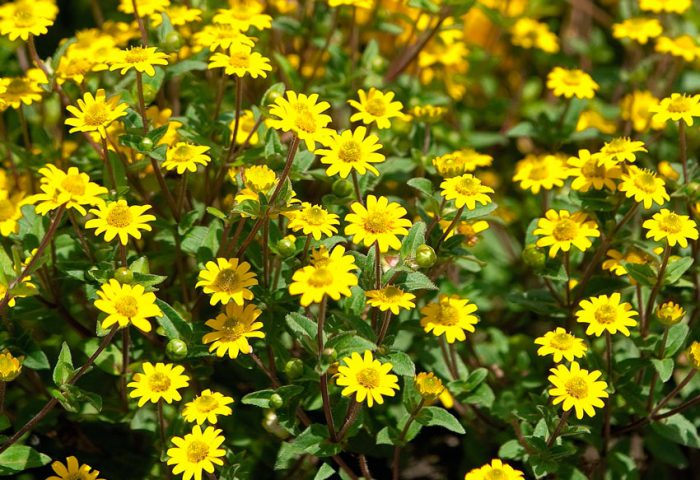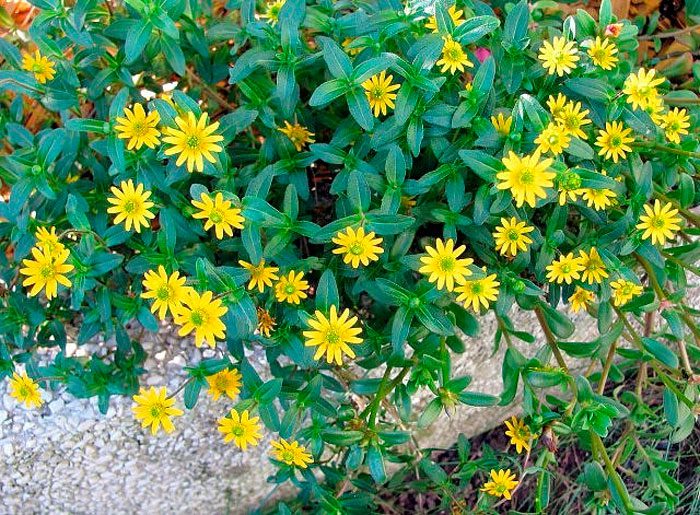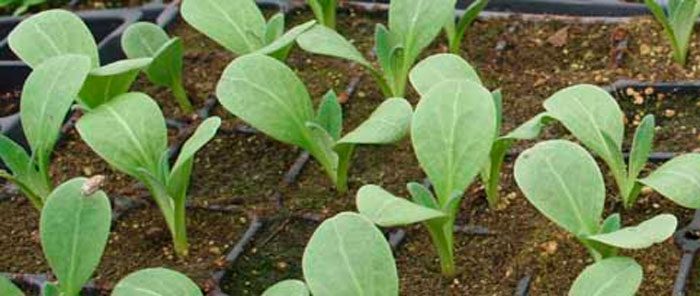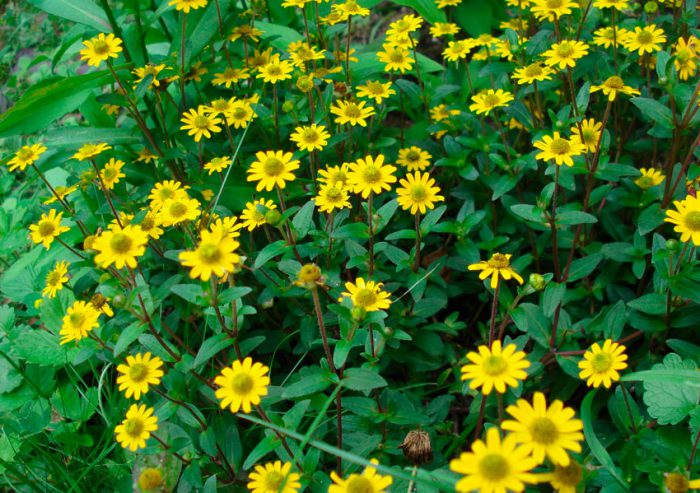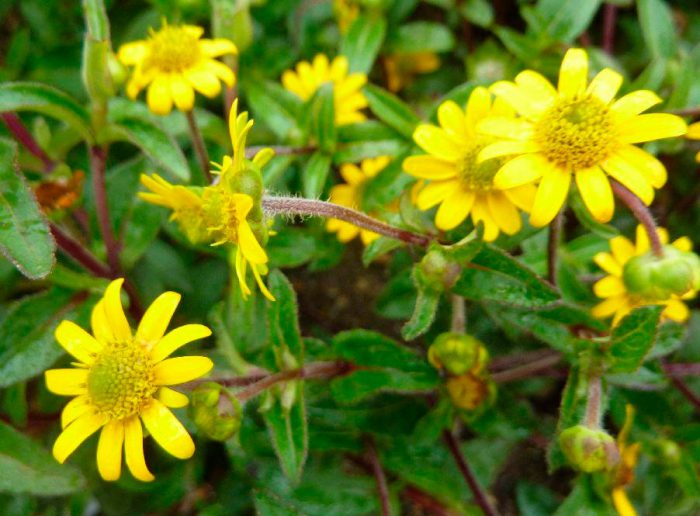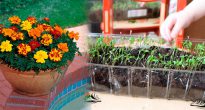The low-growing herbaceous annual or perennial plant Sanvitalia is a member of the Asteraceae or Asteraceae family. This genus unites only 7 species. In natural conditions, such plants can be found in Central and North America. This genus was named after the Italian Sanvitali, who was a botanist. The most popular among gardeners is the type of recumbent or prostrate sanvitalia (Sanvitalia procumbens), it has been cultivated since the 18th century.
Content
Features of sanitation
Sanvitalia's bushes are spherical, and they reach no more than 20 centimeters in height. The length of the creeping highly branched shoots is about 0.45 m. Opposite leaf plates, painted in a deep green color, have a petiole and an ovoid or oblong-ovoid shape. Baskets-inflorescences reach 25 mm in diameter, they include marginal ligulate flowers of yellow, orange or white color, as well as median tubular flowers, painted in brown, purple-black or pale green. Sanvitalia blooms in the second half of the summer period, and fades in October. The fruit is achene.
You can grow this flower in balcony boxes, in hanging baskets, in rockeries, you can decorate an alpine slide with it, or frame flower beds and garden paths. And sanvitalia is also used as a ground cover plant. This plant is not only compact, but also unpretentious, therefore it is very often grown both in the open field and in indoor conditions. Sanvitalia is recommended to be combined with forget-me-nots, iberis, nasturtium and salvia.
Growing sanitation from seeds
Sowing
It is quite easy to propagate sanitary seeds by seeds, because they have a very high percentage of germination. Therefore, do not forget to collect them in the autumn. Sowing seeds for seedlings must be done in the first days of March. To do this, a drainage layer is laid on the bottom of the bowl, which is covered with coarse sand mixed with nutritious garden soil (1: 3), the seeds are buried by only 10 mm. It is necessary to fill the seeds with a thin layer of soil, then the crops are moistened from the sprayer. The container is covered with a film or glass and removed to a slightly cool place (from 18 to 20 degrees). The first seedlings should appear after 10-12 days. Do not forget to air the crops once a day and water them once every two or three days, resorting to bottom watering.When two real leaf plates appear, the plants are picked, while 2 or 3 pieces are placed in one cup. After they take root well, they should be hardened for 15 days, and then planted in open ground.
Transplanting
It is necessary to plant seedlings in open soil in May – June after the night frosts are left behind. For planting, you should choose a sunny site, while taking into account that the plant needs a moderately fertile soil. Make landing holes ten centimeters deep, and do not forget to keep a distance of 25 centimeters between them. At the bottom of each hole you need to put a handful of expanded clay. Then you need to pass the plant into the hole, along with a lump of earth, and cover it with soil. After the soil is slightly compacted, the planted plant should be watered abundantly.
In those regions where spring comes early and it is warm, sowing seeds can be done directly in open soil in May or June. It will be possible to thin out the seedlings after their height reaches 10 centimeters.
Caring for sanitation in the garden
Since sanvitalia is an undemanding and unpretentious plant, it will be quite easy to grow it. Watering such a flower should be moderate. If the weather is damp outside, then the sanitation need not be watered at all, as it has enough natural precipitation. Remember that stagnant water in the soil can cause rot on the root system, while a slight drought will not negatively affect flowering. After the end of watering, it is imperative to loosen the surface of the site, and do not forget to pull out all the weeds.
In the event that the area where these flowers grow is located in a strong wind, then to maintain the shape of the bushes, it is recommended to install frame supports.
If sanvitalia is grown in nutrient-rich soil, or you added fertilizers to it during planting, there is no need to additionally feed the plant. In other cases, feeding is arranged once every 2 weeks and a complex mineral fertilizer is used for this.
To make the plants more bushy, it is necessary to pinch the ends of the stems several times, and you need to have time to do this before the sanvitalia blooms.
You can transplant the bushes at any time. Such flowers tolerate transplanting well even during the flowering period.
Diseases and pests
Sanvitalia has a fairly high resistance to pests and diseases. Problems can arise with the plant only if the watering regime is violated (too abundant or too rare watering). However, remember that the plant tolerates a slight drought better than stagnant liquid in the soil. If you notice that the leaf plates of the flower have begun to curl and have changed their color, then this indicates that it needs urgent watering.
During the cultivation of seedlings, she may develop a disease such as black leg. The reason for the development of this fungal disease is cramped conditions, excessive moisture in the soil and lack of fresh air. For prevention purposes, do not forget to air the seedlings in a timely manner, and also develop the correct watering regime.
Sanvitalia after flowering
Since this flower belongs to the thermophilic, and it can be ruined by an air temperature below minus 3 degrees, sanvitalia is cultivated in middle latitudes only as an annual. However, if desired, the bushes can be saved until spring. To do this, in the autumn, they must be transplanted into a flowerpot, which is removed for storage in a cool (about 5 degrees) room.
Types and varieties of sanitation with photos and names
It has already been said above that only 1 species is cultivated by gardeners - the sanitation is widespread.However, a fairly large number of varieties and hybrids of such a plant were obtained. For instance:
- Bright eyes... The tubular flowers are almost black, and the ligulate ones have a rich orange color.
- Honey saved... This variety is distinguished by abundant flowering. The tubular flowers are dark brown, and the ligulate flowers are honey-yellow. During flowering, these plants create a spectacular carpet.
- Gold Braid... The bushes reach a height of 20 centimeters and grow widely. The flowers are yellow, and the central part is black.
- Aztec Gold... The yellow flowers have a light green center.
- Orange Sprite... The leaf plates are dark green, and the semi-double inflorescences are orange.
- A million suns... This ampelous variety has light green tubular and yellow reed flowers. It is necessary to care for such a flower in the same way as for another creeping or climbing plant.
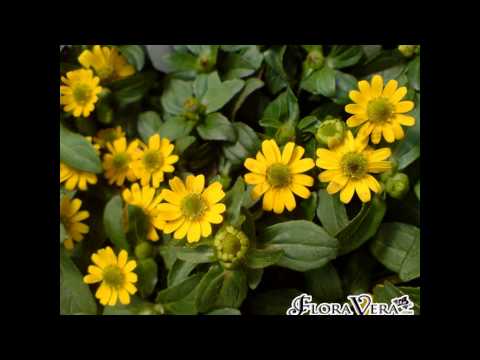

Watch this video on YouTube

